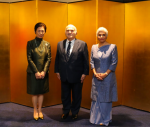You are here
A world of debt
May 24,2023 - Last updated at May 24,2023
WASHINGTON, DC — Recent headlines seem to augur a global debt crisis. The United States is teetering on the precipice of a self-inflicted default. Egypt, Ghana, Pakistan, and many other countries are in grave financial difficulties. Italy and Japan’s debt burdens have grown heavier. And the Chinese are delaying or hampering multilateral efforts to restructure low- and middle-income countries’ debt. The International Monetary Fund (IMF) counts 41 countries as being heavily indebted, and that does not include middle-income countries such as Argentina, Pakistan, and Sri Lanka.
The concerns these stories have fueled are real, but there are fundamental differences between them. The US has the capacity to service its debts, and it has been a reliable borrower for many years. Its problem is political. By contrast, the question for poorer countries is whether, or how much, they can repay. Many heavily indebted low-income countries have debt levels that are already unsustainable or will be soon. Some have missed payments or announced that they will have to suspend debt service. Private lenders have responded by refusing to lend more.
But this cohort of indebted countries can be broken down further into two groups. Some countries were in relatively satisfactory positions until COVID-19 forced them to borrow more to finance pandemic-related expenditures. International financial institutions have created special facilities to help these countries secure rapid additional financing, and to sustain normal financing as their economies recover.
The other group already had high and rising debts before COVID-19, often because they had splurged on projects with low or negative rates of return. Sri Lanka is a case in point. A new government took office in 2019 and cut taxes dramatically, increasing already large fiscal deficits and borrowing even more. While ill-advised domestic policies, notably a prohibition on imported agricultural inputs, sharply reduced the country’s agricultural production, the government spent down its foreign-exchange reserves and then borrowed at higher interest rates (especially from China) until it could borrow no more.
Because many heavily indebted countries rely on imports for essential food, medicines and intermediate goods, an inability to finance imports during a crisis can result in factory closures and a sharp decline in economic activity, as happened in Sri Lanka. Until the afflicted country acquires the foreign exchange needed to finance renewed import flows, essentials will remain scarce.
In these cases, the IMF works with the government to formulate policies to enable the country to restore growth and creditworthiness. If the IMF did not insist on such reforms, it would merely be increasing the country’s indebtedness and postponing an inevitable reckoning. Hence, to ensure that the country follows through, the IMF generally disburses funds in tranches as reforms are carried out, with the initial disbursement enabling a resumption of import flows and debt servicing.
Recognising the impact of such crises on the poor, some observers have called for debt reduction and new funds to be offered without any condition that the country correct the policy failures that led to extreme indebtedness. But in assuming that new lending will help the poor, they fail to see that this is often a case of “throwing good money after bad”. In many cases, one reason why the country is poor is that its previously accumulated debt went toward low-productivity investments.
Despite the long process that the IMF undertakes before agreeing to a programme, additional complications may emerge after it is established. When the IMF deems a country’s debt burden too heavy for it to sustain its debt-servicing requirements, restructuring of sovereign debt must be part of the agreed IMF programme and negotiated with private and public creditors. Sometimes, reforms and IMF money can help a country achieve growth and finance its debt service. But in other cases, the debt has become so large that it is unreasonable to expect the country to resume servicing it fully. To address this issue, officials from the creditor countries’ governments will meet and agree on debt-restructuring terms, which might include a reduction in the face value of the debt, a rescheduling of principal repayments, or even a grace period. Traditionally, private creditors will also participate in these talks and agree to a haircut on outstanding debt.
But China’s rise as emerging and developing economies’ largest bilateral creditor has frustrated matters. The Chinese have been reluctant to restructure debts, and have insisted on lending to debtor countries whatever they need to cover their obligations. If the IMF disbursed funds under those conditions, some portion of them would simply go to repay China, which would then be treated more favorably than other creditors.
IMF programmes therefore cannot be implemented until all creditors have reached an agreement on restructuring. Sri Lanka could not receive funds from the IMF for months because the Chinese refused to take a haircut on loans they had made. Instead, they wanted to lend even more money to Sri Lanka so that it could service its debt (and increase its overall debt to China). Likewise, Zambia’s restructuring has been delayed since November 2020.
True, China finally has made some arrangements with several countries that would enable the IMF to disburse funds. But many other indebted countries still need to undertake policy reforms in accordance with an agreed IMF programme, which means that more delays can be expected. One hopes that China will see that it is in its own interest to devise a smoother, faster process for policy reforms and debt restructuring.
Anne O. Krueger, a former World Bank chief economist and former first deputy managing director of the International Monetary Fund, is senior research professor of International Economics at the Johns Hopkins University School of Advanced International Studies and senior fellow at the Centre for International Development at Stanford University. Copyright: Project Syndicate, 2023. www.project-syndicate.org













